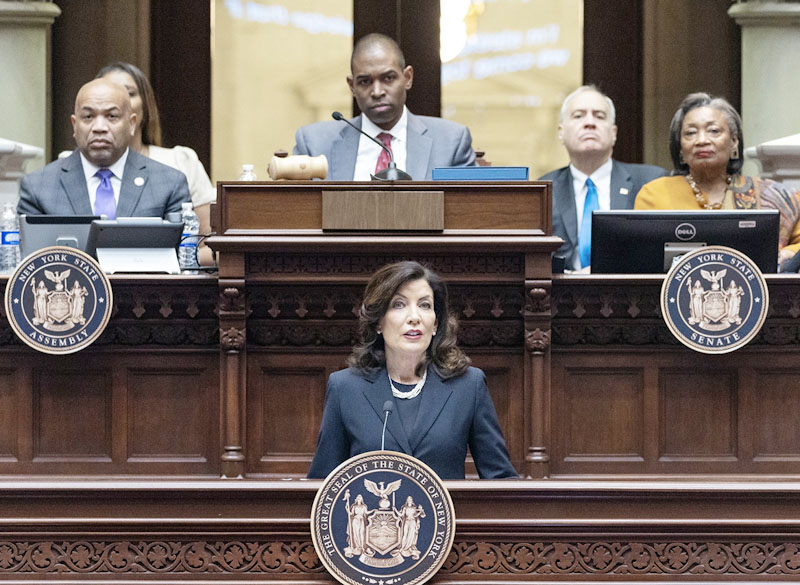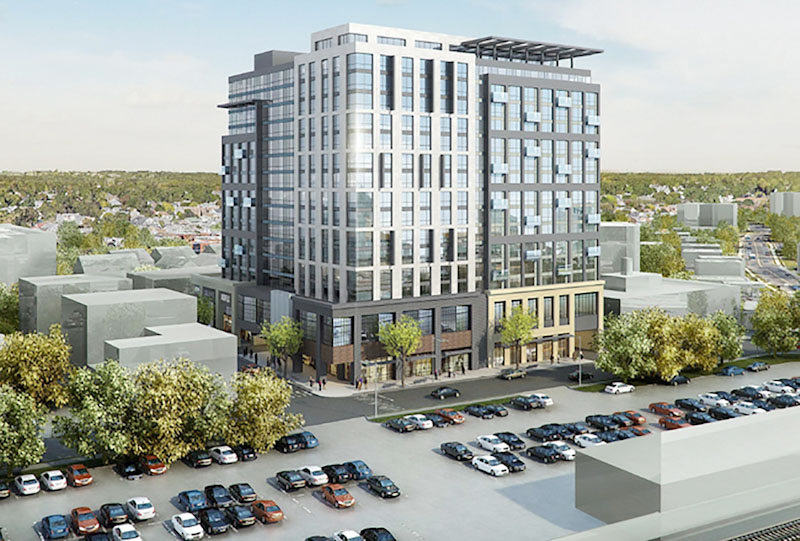Gov’s Ambitious Housing Plan Pledges New Funding for Roads, Schools, Sewers
By JOHN JORDAN – January 20, 2023
ALBANY—Presenting her first State-of-the-State address as the duly elected governor—after traveling a bumpy road that included an historic resignation of a former governor and her own election campaign fraught with last-minute uncertainty—New York Gov. Kathy Hochul on Jan. 10 outlined key initiatives that included an ambitious plan to address the affordable housing crisis in the state.
The governor introduced her “New York Housing Compact,” a groundbreaking strategy to catalyze housing development that has a goal of creating 800,000 new units in the next decade. She said the state will provide assistance to localities to meet the housing goal by offering “substantial new funding for infrastructure like schools, roads and sewers needed to support growing communities.”
Every single locality across the state will have a target for building new homes, she noted. Upstate, the target is for the current housing stock to grow by 1% every three years. Downstate, 3% every three years. She added that as part of

the compact, any municipality with a train station should rezone the area within a half-mile of the station that would allow for the creation of new housing within the next three years.
Gov. Hochul also promised a replacement for the 421a subsidy in New York City. “The reality is that we can’t meet the demand for housing without an incentive program like 421a in New York City. Without it, developers will only build condominiums or build elsewhere, which isn’t the outcome we need. To meet our housing goals, we will work with the Legislature on a replacement for this critical piece of the puzzle.”
“New York State needs an ambitious vision that encourages growth, sustainability and equity, and Gov. Hochul has demonstrated a bold and decisive roadmap that will benefit all New Yorkers,” said Carlo A. Scissura, Esq., president and CEO of the New York Building Congress. “It is no surprise that the governor’s Housing Compact to generate 800,000 new homes over 10 years so closely aligns with the Building Congress’ 2023 Policy Agenda—our members know what it will take to build our way out of this crisis, and the governor has always understood the importance of our industry.”
These items include zoning policies that prioritize transit-oriented development, removing the residential FAR cap of 12, facilitating the conversion of office spaces into housing, replacing the 421a property tax exemption, facilitating new housing stock via Fast Track Approval, and providing $250 million to support critical infrastructure projects.
Many business and political leaders praised the governor’s housing initiative. The Welcome Home Westchester alliance, which is advocating for more affordable housing development in Westchester County, said in a statement that “at the heart of our housing affordability crisis—every community in the Greater New York City area played a role in creating this housing shortfall. Every community needs to do what it can to be a part of the solution.” Alliance members include the Building and Realty Institute, the Hudson Gateway Association of Realtors and the Westchester County Association.
The group noted that the recently completed Westchester County Housing Needs Assessment found that our county needs to build 11,703 new units of housing just to meet the present-day need. “A gap that large doesn’t happen by accident. Over the previous decades, the fragmented municipality-by-municipality land use system we built made it too easy to create barriers to housing, create delays for approvals, pass the buck to other neighborhoods or other towns when it came to housing affordability, or fail to update local zoning codes such that we are often trying to squeeze our 21st century needs into a tool designed for a mid-20th century lifestyle. It has simply been too easy for too long to avoid building the housing we need.”
The New York State Association of Realtors also praised the governor’s housing compact. “We support the Governor’s New York State Housing Compact…Also key to successfully moving forward is a commitment by New York State and its local governments to improve the regulatory climate that currently does not promote housing development. We encourage all lawmakers and regulators to rethink local building code and zoning rules that have been a root cause of the current housing shortage.”
New York State is a “home rule state,” so opposition to imposing edicts to local municipalities from some local officials is likely.

Rockland County Executive Ed Day said, “I am concerned as well about some of the mandates included in the Governor’s new NY Housing Compact that will require municipalities to change zoning in specific areas of their communities and meet mandatory home growth targets. As your County Executive, and past president of a local civic association, I believe this concept to be contradicted by the Constitution of New York State and will continue to stand firmly in opposition to any politically based plan that undermines New York State Home Rule regulations and municipal zoning ordinances.”
He also is concerned about possible legislation that would allow, promote and possibly reward homeowners for building out Accessory Dwelling Units.
“While creating affordable housing is an admirable goal, our own Planning Department stated in its professional assessment the one-size-fits-all approach of the ADU legislation is extremely problematic and does not account for differences between rural, suburban, and urban communities,” Mr. Day added. “I’m concerned there is a strong likelihood that the character of our county could be changed forever.”
The governor also outlined in the State-of-the-State some key initiatives to reduce crime and gun violence and enhance mental health services.
AT-A-GLANCE
Gov. Hochul’s ‘New York Housing Compact’
ALBANY—Under the “New York Housing Compact” outlined by Gov. Kathy Hochul in her State-of-the-State address on Jan. 10, localities will decide how to best meet their new home construction targets. From repurposing underutilized office parks and strip malls to offering new incentives toward multifamily buildings, localities can choose how to tailor their strategies to increase housing supply.
To encourage the inclusion of affordable housing as part of the new growth, affordable units will be assigned extra weight in calculating localities’ progress toward their goals.
Localities that do not meet targets can achieve Safe Harbor status for one three-year cycle by implementing certain good faith actions—or “Preferred Actions”—that create zoning capacity to achieve the growth targets. In municipalities where there is no market demand for new housing, there will be no practical effect if localities fall short of their targets.
The New York Housing Compact will make available a $250 million Infrastructure Fund and $20 million Planning Fund to support new housing production statewide. Municipalities may submit requests for planning funding to undertake either required Transit-Oriented Development rezonings or Preferred Actions to help them hit their growth targets. The plan will also create a new Housing Planning Office within New York State Homes and Community Renewal to provide municipalities with support and guidance.
The New York Housing Compact will require that localities with rail stations run by the MTA undertake a local rezoning or higher density multifamily development within half a mile of the station unless they already meet the density level. By expanding housing potential in these transit-oriented communities, more families will be able to enjoy improved access to jobs and thriving sustainable communities.
After three years, in localities that do not meet growth targets or do not take steps to implement Preferred Actions, proposed housing developments that meet particular affordability criteria, but may not conform to existing zoning, may take advantage of a fast-track housing approval process if the locality denies the permit. The appeal can be made to a new State Housing Approval Board or through the courts. Appealed projects will be approved unless a locality can demonstrate a valid health or safety reason for denying the application.
To expedite rezoning and development of new homes, specific relief from environmental review will be included in the New Homes Targets and Transit Oriented Development proposals. The state will continue to exercise crucial safeguards that prevent environmental harm and ensure that public health remains a top priority.
Ways to Incentivize New Housing, Rehab Existing Housing
Gov. Hochul also unveiled a series of new proposals to incentivize new housing construction and the rehabilitation of existing housing. She discussed new property tax exemptions to encourage mixed income housing development near train stations, and incentivizing affordable housing in commercial buildings that are converted to residential use in New York City.
- Also listed were updated property tax exemptions offered by local option to support homeowners that build Accessory Dwelling Units and for property owners who need support undertaking certain renovations in New York City.
- To support the development of mixed-income housing outside of New York City, Gov. Hochul will direct New York State Homes and Community Renewal to make $5 million in State Low Income Housing Tax Credits available.
- Gov. Hochul will also make necessary changes to ensure that localities where new housing developments utilize Payment in Lieu of Taxes agreements are not penalized in tax cap calculations.
